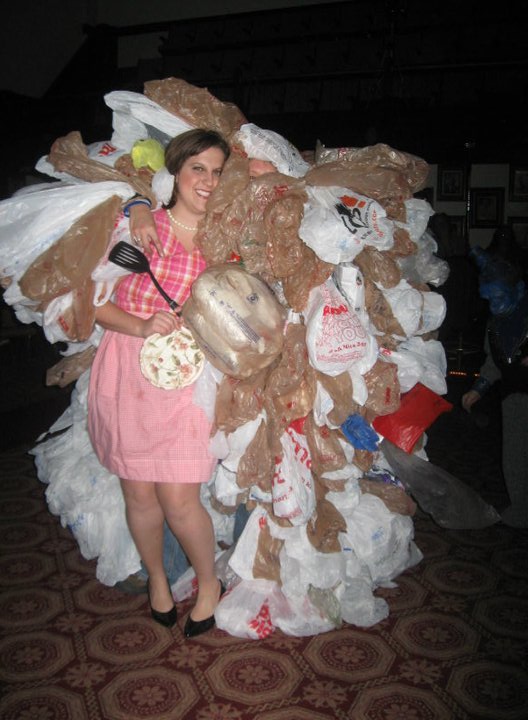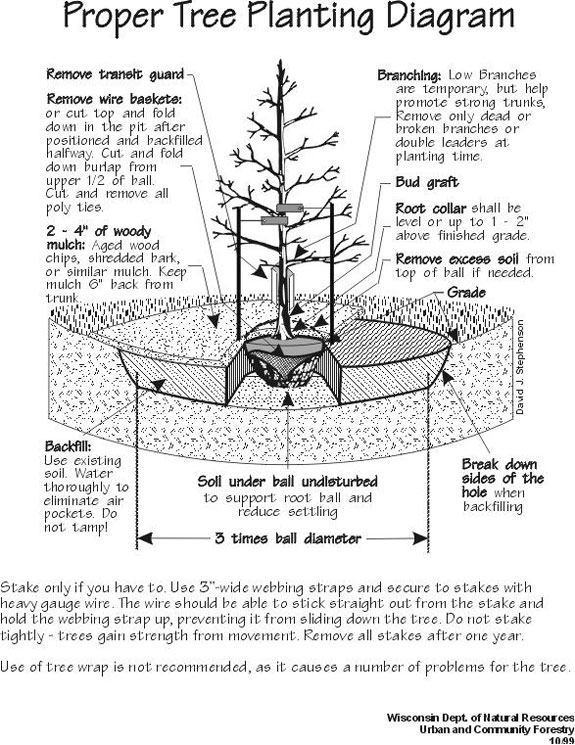I took 2 weeks to make my Halloween costume. I collected 4 women’s household plastic bags and about 20 of my own. All the bags were sewn onto a trench coat to make “Bag Monster.” My Bag Monster had 688 attached bags that I wore for Halloween…and passed out this fact sheet. If you thought I looked ridiculous, think of how ridiculous bags truly are…
bag-monster.doc
Why plastic bags blow?
*Plastic bags start as crude oil, natural gas, or other petrochemical derivatives.
*The first plastic baggies for bread, sandwiches, fruits, and vegetables were introduced in the United States in 1957. Plastic trash bags started appearing in homes and along curbsides around the world by the late 1960s and handed out by the millions in 1977.
*A quarter of the plastic bags used in wealthy nations are now produced in Asia.
*Only 0.6 percent of plastic bags are recycled NOT EVEN A WHOLE PERCENT
*News sources cite a 500-year estimate for a plastic bag to decompose in a landfill, while others prefer a more conservative 1,000-year lifespan. In full sunlight plastic bags can take as little as 20 years
but when plastics break down, they dont biodegrade; they photodegrade. This means the materials break down to smaller fragments which readily soak up toxins. They then contaminate soil, waterways, animals and eventually humans to digest.
*Some manufacturers have introduced biodegradable or compostable plastic bags made from starches, corn, polymers or poly-lactic acid, and no polyethylenethough these remain prohibitively expensive and account for less than 1 percent of the market.
Take Action SIMPLE THINGS YOU CAN DO!
*Think twice about taking a plastic bag if your purchase is small and easy to carry.
*Keep canvas bags in your home, office, and car so you always have them available when you go to the supermarket or other stores.
*Ask your favorite stores to stop providing bags for free, or to offer a discount for not using the bags. NO PAPER OR PLASTIC
*Encourage your local politicians to introduce legislation taxing or banning plastic bags.
*Try to go at least one week without accumulating any new plastic bags. If every shopper took just one less bag each month, this could eliminate the waste of hundreds of millions of bags each year.
*DONT FEED THE BAG MONSTER!!!!!!!!!!!!!!!!!!!!!!!!!!!!!!!!!!!!!!!!!!!!!!!!!!!!!!!!!

Wanna know something really ridiculous?
* Somewhere between 500 billion and a trillion plastic bags are consumed worldwide each year
*Each year the U.S. consumes between 30 billion-100 billion plastic bags and 10 billion paper grocery bags.
*The average American uses 300 to 700 plastic bags per year.
(1,400 bags for a family of 4)
*If everyone in the United States tied their annual consumption of plastic bags together in a giant chain, the chain would reach around the Earth 760 times!
*10% of the plastic you consume ends up in the ocean.
ALL litter that is not picked-up, eventually ends up in the nearest waterway
.
BACKGROUND ON PAPER BAGS
*Each year the United States consumes 10 billion paper grocery bags, requiring 14-17 million trees.
*According to the EPA, paper bags generate 70 percent more air pollution and 50 times more water pollution than plastic bags.
*Five industries account for 68 percent of all energy used in the industrial sector. Pulp and paper accounts for 6 percent of energy usage making it the fourth largest contributor
and Indiana continues to rely on burning coal for generating 96% of our energy.
The Great Pacific Garbage Patch is now 2x the size of Texas.
*The worlds largest concentration of plastic pollution can be found floating mostly below the surface between Hawaii and San Francisco. Wind and sea currents carry marine debris from all over the world to what is now known as the Great Pacific Garbage Patch. This landfill is estimated to be twice the size of Texas and millions of pounds of our discarded trash, mostly plastics.
*It would take you a week to boat across the 3.5 million of tons of garbage strewn across the “Patch.” The garbage reaches depths of nearly 100 feet.
*Trash in the ocean is known to be the cause of death and injuries of numerous marine animals and birds because they become entangled in it, or mistaken it for prey and eat it or regurgitate it to young.
*At least 267 different species are known to have suffered from entanglement or ingestion of marine debris including seabirds, turtles, puffins, seals, sea lions, whales and fish.
*Scientists find many seabird skeletons on the Hawaiian Islands whose “gut content is just filled with plastic.” As the larger animals and marine life eat the smaller animals, the plastic eventually ends up in the human food supply, too.
*According to a 2006 report from the U.N. Environment Programme, every pound of plankton in the central Pacific Ocean is offset by about 6 pounds of litter. The report adds that every square mile of ocean is home to nearly 50,000 pieces of litter.
Sources:
1. The Environmental Literacy Council. Paper or Plastic? 2008 – View Full Article
2. United States Environmental Protection Agency. Questions About Your Community: Shopping Bags: Paper or Plastic or …? – View Full Article
3. Wall Street Journal. Paper or Plastic? A New Look at the Bag Scourge. – View Full Article by Jeffrey Ball
4. National Geographic News. Giant Ocean-Trash Vortex Attracts Explorers – View Full Article by Brian Handwerk
5. Greenpeace. Plastic Debris in the World’s Oceans. – View Full Report by Allsopp, Walters, Santillo, and Johnston
6. National Geographic News. Are Plastic Grocery Bags Sacking the Environment? – View Full Article by John Roach
7. Gloucester Times. Taking Our Own Steps to Fight Ocean Pollution. View Full Article by Heidi Pearson
8. CNN.com. Scientists Study ‘Garbage Patch’ in Pacific Ocean. View Full Article by Shelby Lin Erdman
9. New York Times. Recyclers, Scientists Probe Great Pacific Garbage Patch. View Full Article by Colin Sullivan
10. National Cooperative Grocers Association. Paper or Plastic? NCGA Suggests Neither. – View Full Article
11. Energy Information Administration. International Energy Outlook 2009, Industrial Sector Energy Consumption. View Full Article






